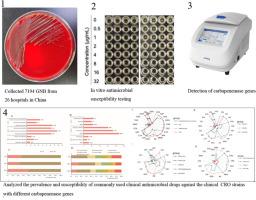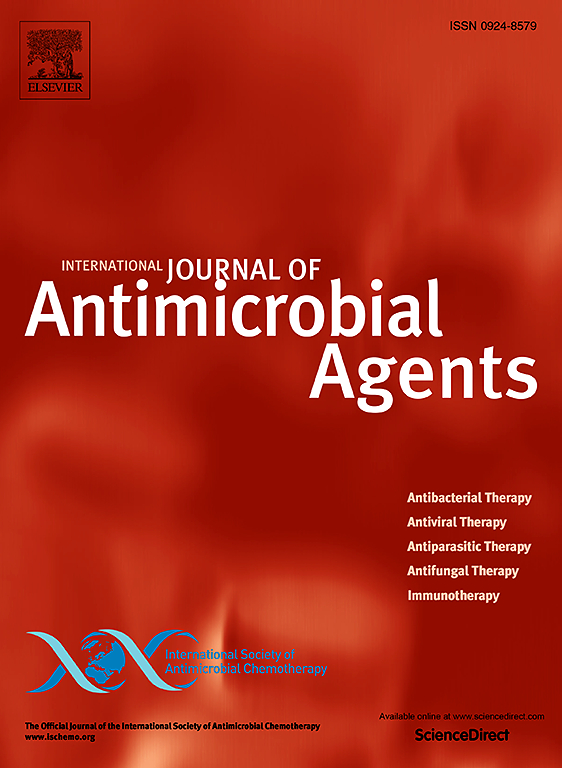In-vitro activities of essential antimicrobial agents including aztreonam/avibactam, eravacycline, colistin and other comparators against carbapenem-resistant bacteria with different carbapenemase genes: A multi-centre study in China, 2021
IF 4.9
2区 医学
Q1 INFECTIOUS DISEASES
International Journal of Antimicrobial Agents
Pub Date : 2024-09-18
DOI:10.1016/j.ijantimicag.2024.107341
引用次数: 0
Abstract
Objective
Carbapenem-resistant bacteria (CRB), including carbapenem-resistant Acinetobacter baumannii (CRAB), carbapenem-resistant Pseudomonas aeruginosa (CRPA) and carbapenem-resistant Enterobacterales (CRE), pose a considerable threat to public health in China. Eravacycline, aztreonam/avibactam and colistin are important antimicrobial agents for the treatment of serious infections caused by CRB. This study aimed to evaluate the prevalence of CRB strains, and the susceptibility of commonly used clinical antimicrobial agents against strains with different carbapenemase genes.
Methods
In total, 7194 gram-negative bacteria strains were collected from different regions of China, and 924 carbapenem-resistant strains were identified. All strains were from confirmed infections. Antimicrobial susceptibility testing, covering 21 antimicrobial agents including aztreonam/avibactam, eravacycline, colistin and other comparators, was performed using the broth microdilution method. Carbapenemase genes (blaKPC, blaNDM, blaOXA, blaIMP and blaVIM) were screened using polymerase chain reaction amplification and sequence analysis. All statistical analyses were performed using Statistical Package for the Social Sciences Version 23.0.
Results
The isolation rates of CRE, CRAB and CRPA were 6.31% (332/5265), 62.95% (440/699) and 15.20% (152/1000), respectively. The predominant carbapenemase in carbapenem-resistant Escherichia coli (CRECO) was NDM, while in carbapenem-resistant Klebsiella pneumoniae (CRKP), it was KPC. All CRAB produced OXA-23, and 85.52% of CRPA did not produce any of the following carbapenemases: NDM, KPC, VIM, IMP and OXA. Aztreonam/avibactam, colistin and eravacycline exhibited high antimicrobial activity against different species producing various carbapenemases. Compared with ceftazidime/avibactam, aztreonam/avibactam demonstrated superior antimicrobial activity, particularly pronounced in CRECO and strains producing metallo-beta-lactamases. In comparisons between tigecycline and eravacycline, the latter maintained higher antimicrobial activity across different species. Antimicrobial agents exhibited varying levels of activity against strains with different resistance mechanisms.
Conclusions
Using aztreonam/avibactam, eravacycline and colistin to treat infections caused by CRB offers significant advantages. These findings will guide clinical practice and optimize antimicrobial administration.

2021 年中国一项多中心研究:阿曲南/阿维菌素、埃拉伐环素、可乐定等基本抗菌药物和其他比较药物对不同碳青霉烯酶基因的碳青霉烯耐药菌的体外活性。
目的:耐碳青霉烯类细菌(CRB),包括耐碳青霉烯类鲍曼不动杆菌(CRAB)、耐碳青霉烯类铜绿假单胞菌(CRPA)和耐碳青霉烯类肠杆菌(CRE),对中国的公共卫生构成了相当大的威胁。依拉维辛、阿曲南/阿维巴坦和可乐定是治疗 CRB 引起的严重感染的重要抗菌药物。本研究旨在评估CRB菌株的流行率以及临床常用抗菌药物对具有不同碳青霉烯酶基因的菌株的敏感性:我们从中国不同地区收集了7194株革兰阴性菌(GNB),并鉴定出924株碳青霉烯耐药菌株。所有菌株均来自确诊的感染。采用肉汤微稀释法进行了抗菌药敏感性检测,涵盖 21 种抗菌药,包括阿卓那姆/阿维巴坦、克拉维西林、可乐定和其他比较药。通过 PCR 扩增和序列分析筛选碳青霉烯酶基因(blaKPC、blaNDM、blaOXA、blaIMP 和 blaVIM)。所有统计分析均使用社会科学统计软件包 23.0 版软件进行:结果:CRE、CRAB 和 CRPA 的分离率分别为 6.31%(332/5265)、62.95%(440/699)和 15.20%(152/1000)。耐碳青霉烯类大肠埃希菌(CRECO)的主要碳青霉烯酶是 NDM,而 CRKP 的主要碳青霉烯酶是 KPC。所有 CRAB 都产生 OXA-23,85.52% 的 CRPA 不产生以下任何一种碳青霉烯酶:NDM、KPC、VIM、IMP 和 OXA。氨曲南/阿维菌素、可乐定和依拉维辛对产生各种碳青霉烯酶的不同菌种具有很强的抗菌活性。与头孢唑肟/阿维巴坦相比,唑来南/阿维巴坦的抗菌活性更强,尤其是对 CRECO 和产生金属-β-内酰胺酶(MBLs)的菌株。在对替加环素和埃拉伐环素进行比较时,后者在不同菌种中保持了更高的抗菌活性。针对具有不同耐药机制的菌株,抗菌剂表现出不同程度的活性:我们的研究结果表明,使用唑曲南/阿维菌素、克拉维酸和可乐定治疗 CRB 引起的感染具有显著优势。这些结论将指导临床实践,优化抗菌药物的使用。
本文章由计算机程序翻译,如有差异,请以英文原文为准。
求助全文
约1分钟内获得全文
求助全文
来源期刊
CiteScore
21.60
自引率
0.90%
发文量
176
审稿时长
36 days
期刊介绍:
The International Journal of Antimicrobial Agents is a peer-reviewed publication offering comprehensive and current reference information on the physical, pharmacological, in vitro, and clinical properties of individual antimicrobial agents, covering antiviral, antiparasitic, antibacterial, and antifungal agents. The journal not only communicates new trends and developments through authoritative review articles but also addresses the critical issue of antimicrobial resistance, both in hospital and community settings. Published content includes solicited reviews by leading experts and high-quality original research papers in the specified fields.

 求助内容:
求助内容: 应助结果提醒方式:
应助结果提醒方式:


